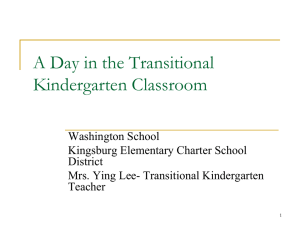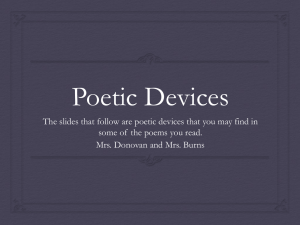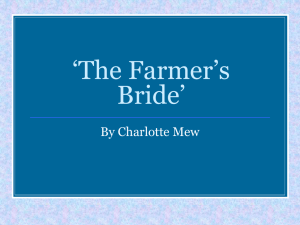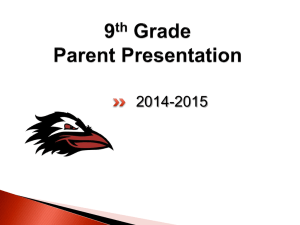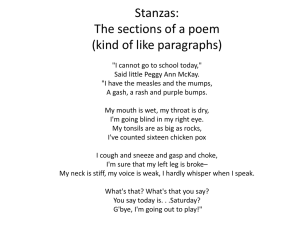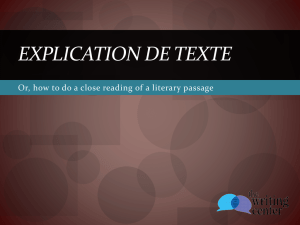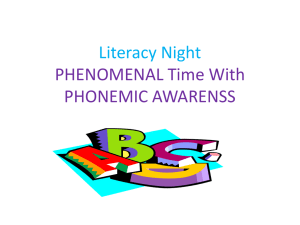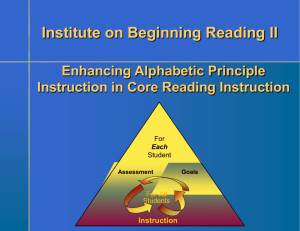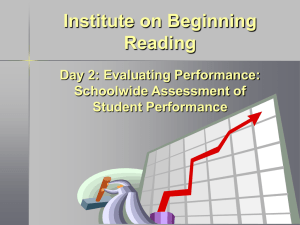Powerpoint K PALS-Final - Ingham Intermediate School District
advertisement
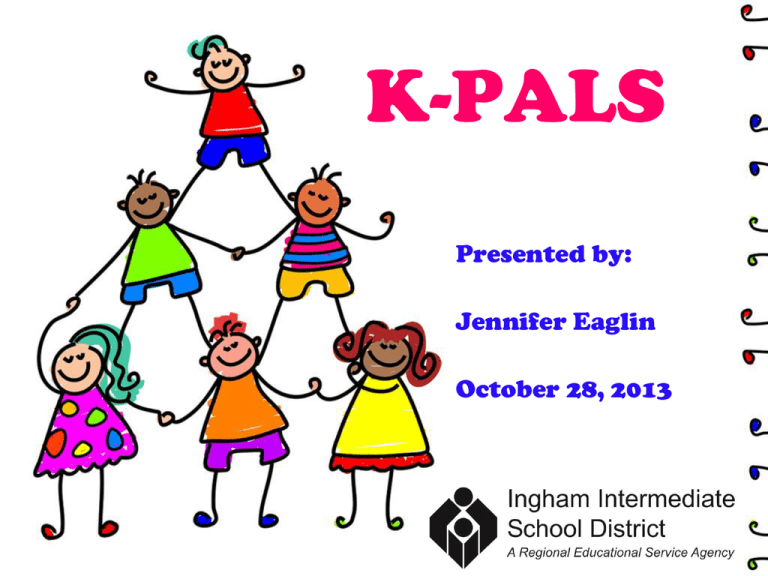
K-PALS Presented by: Jennifer Eaglin October 28, 2013 Norms To make this day the best possible, I need your assistance and participation • Be Responsible – Attend to the “Come back together” signal – Active participation…Please ask questions/Or use Parking Lot – Take care of your own needs • Be Respectful Please allow others to listen Please turn off cell phones Please refrain from emailing and private browsing Agenda for K-PALS 1. Overview of the Big 5 for Literacy 2. Rationale and benefits of using PALS 3. Introduction to K-PALS 4. Practice activities with partners 5. Implementation Tips 3 Exit Outcomes • By the end of this session you will be able to, – Discuss the research and rationale for using PALS strategies – Understanding of the Big 5 in literacy – Implement PALS at your grade level Five Big Ideas Identified by the National Reading Panel (NRP) • • • • • Phonemic Awareness Alphabetic Principle Fluency Vocabulary Comprehension What the Research Says About Phonological Awareness (PA) • Phonological awareness is necessary but not sufficient for reading acquisition. • Phonological awareness is teachable and promoted by attention to instructional variables. (Smith, Simmons, & Kame'enui, 1998) “Reading and phonemic awareness are mutually reinforcing: Phonemic awareness is necessary for reading, and reading, in turn, improves phonemic awareness still further.” (Shaywitz, 2003, pg. 55) Simmons, Harn, & Kame'enui © 2003 MiBLSi What Skills Does PA Include? Phonological Awareness Development Continuum • Word comparison –Rhyming • Sentence segmentation – Syllable segmentation & blending Onset-rime blending and segmentation Blending & segmenting individual phonemes Phoneme deletion & manipulation (Modified from O'Connor, Notari-Syverson, & Vadasy, (1998). High Priority Skills Simmons, Harn, & Kame'enui © 2003 What the Research Says About Alphabetic Principle • Letter-sound knowledge is prerequisite to effective word identification. A primary difference between good and poor readers is the ability to use letter-sound correspondences to identify words. (Juel, 1991) • Students who acquire and apply the alphabetic principle early in their reading careers reap long-term benefits. (Stanovich,1986) • Teaching students to phonologically recode words is a difficult, demanding, yet achievable goal with long-lasting effects. (Liberman & Liberman, 1990) Harn, Simmons, & Kame'enui © 2003 MiBLSi What is Accuracy & Fluency with Connected Text Reading? • The ability to translate letters-to-sounds-towords fluently, effortlessly. LaBerge and Samuels (1974) described the fluent reader as "one whose decoding processes are automatic, requiring no conscious attention" (e.g., Juel, 1991). Such capacity then enables readers to allocate their attention to the comprehension and meaning of the text. Simmons, Harn, & Kame'enui © 2003 MiBLSi A change in what the research Says about vocabulary Effective vocabulary instruction: Promotes wide independent reading The best way to foster vocabulary growth is to promote wide reading “Research has shown that children who read even ten minutes a day outside of school experience substantially higher rates of vocabulary growth between second and fifth grade than children who do little or no reading.” (Anderson & Nagy, 1992, p. 46) Coyne, Kame'enui, & Chard © 2003 MiBLSi What the Research Says About Vocabulary • A student in the 20th percentile reads books ______ minutes a day. .7 • This adds up to 21,000 _________words read per year. • A student in the 80th percentile reads books 14.2 minutes a day. ______ • This adds up to 1,146,000 words read __________ per year. Coyne, Kame'enui, & Chard © 2003 MiBLSi 11 What the Research Says About Comprehension Effective comprehension instruction: • Teaches students explicit comprehension strategies that can be applied before, during, and after reading both narrative and expository text For example, the National Reading Panel (2000) concluded that the following strategies have a firm scientific basis for improving text comprehension. • • • • Priming prior knowledge / previewing / predicting Identifying the main idea / summarizing Using text structure / using graphic organizers Answering and generating questions Coyne, Kame'enui, & Chard © 2003 MiBLSi Changing Emphasis of Big Ideas K 1 2 3-6 Phonological Awareness Alphabetic Principle Automaticity and Fluency with the Code Vocabulary Comprehension Letter Sounds & Combinations Multisyllables Listening Reading Listening Simmons, Kame'enui, Harn, & Coyne © 2003 MiBLSi Reading The “big idea” behind PALS • K-PALS specifically addresses Phonemic Awareness and the Alphabetic Principle • First Grade PALS specifically addresses Phonemic Awareness, Alphabetic Principle, Fluency and Comprehension Rationale and Benefits of Peer Assisted Learning Strategies • PALS improves – Word identification (e.g., D. Fuchs et al., 1997) – Reading comprehension (e.g, L. Fuchs et al., 1999) – Social acceptance (D. Fuchs et al., 2002) – Task engagement (Locke & Fuchs, 1995) – Fluency (e.g., Simmons et al., 1994) – Interest in reading (L. Fuchs et al., 1999) Rationale and Benefits of Peer Assisted Learning Strategies • Consistent academic & behavioral gains by PALS students compared to controls using rigorous experimental methods • Considered a “best practice” by U.S. Dept. of Education Rationale and Benefits of Peer Assisted Learning Strategies • Students in kindergarten benefit from phonemic awareness and alphabetic principle and word recognition • K-PALS promotes early reading skills in Kindergarten students, including those with disabilities. • Certain instructional features boost academic performance (e.g. Swanson, 1999) • These features include: – Explicit practice & skill modeling – Immediate, corrective feedback – Small-group work An Important Part of Explicit Instruction I do! We do! Y’all do one! You do one! From: Dr. Anita Archer PALS Materials: Kindergarten/First Grade Teacher Materials – Overhead/Data Projector – Transparencies or photo copies -Partner chart -Rules – K-PALS Manual – Marker – Timer Student Materials – K-PALS folder -scorecard -game sheet – Pencil – Books of various reading levels – A Speed Game Incentives Bag 19 KPALS-Student Games • Name Game • Rhyme Time • First Sound • Say the Word • Last Sound • Stretch It K-PALS Scope & Sequence Game Sheets Weeks Played Games Played 1-15 1-5 Name Game Rhyme Time First Sound 16-30 6-10 Name Game Say the Words First Sounds 31-45 11-15 Name Game Say the Word Last Sound 46-60 16-20 Name Game Stretch It Last Sound K-PALS is conducted for 20 minute sessions, three days a week for about 20 weeks K-PALS Training Page 10 • You will teach students to play the first 3 K-PALS games • Name Game, Rhyme Time, & First Sound (P. 19 in book) • Using Game Sheets 1-3 • Use the 6 fully scripted lesson plans provided • Need about 6, 15-25 minute training sessions • Model the rules, activities, correction procedures in whole group format • Teacher serves as the coach and students as the reader • Gradually individual students get to practice being the coach and the rest of the class the reader • Eventually students start working in pairs while the teacher monitors and provides corrective feedback K-PALS Routines Name GameGame Sheets 1-60 • Steps 1. Coach: “What Letter?” 2. Reader: “m” 3. Switch jobs 4. Reader marks 5 points; Coach fills in smiley face • Correction Procedure 1. Tell: That letter is________ 2. Ask: What letter? 3. Start Again: Start the line again K-PALS Routines Rhyme Time-Game Sheets 1-15 • Steps 1. Coach: says the two words (pictures) and then asks “Do these rhyme?” 2. Reader: yes or no 3. Switch Jobs 4. Readers marks 5 points; Coach fills in smiley face • Correction Procedure 1. Tell: No.____does not rhyme with____ 2. Ask: Do these rhyme? 3. Start Again: Start the Line Again K-PALS Routines First Sound Game-Sheets 1-30 • Steps 1. Coach: says the word (picture) and asks, “What’s the first sound?” 2. Reader: says sound 3. Switch jobs 4. Reader marks 5 points; Coach fills in smiley face • Correction Procedure 1. Tell: No. The first sound is ___ 2. Ask: What’s the first sound? 3. Start Again: Start the line again. K-PALS Routines Say the Word-Game • See p. 90 of manual for details and Game Plan 7 where it is introduced • Oral Teacher Directed Activity at Game Sheet 7 • Becomes a student game on Game Sheet 16 • Slowly segment a word, phoneme by phoneme, raising fingers as cues (Finger Spelling) • Then ask student to “Say the word” • Coaches hold sheet so Readers do not see pictures • Do not switch jobs for this game. K-PALS Routines Last Sound • See p. 121 of manual for details and Game Plan 22 where it is introduced • Oral Teacher Directed Activity at Game Sheet 22 • Becomes a student game on Game Sheet 31 • Say a word and ask, “What is the last sound in the word____?” K-PALS Routines Stretch-It • See p. 146 of manual for details and Game Plan 37 where it is introduced • Oral Teacher Directed Activity at Game Sheet 37 • Becomes a student game on Game Sheet 46 • Say word, “Stretch the word_____. Hold up one finger at a time to lead students (keeping them together) K-PALS Routines Letter-Sounds Correspondence • See p. 146 of manual for details and Game Plans 3760 for where introduced • Introduce same time as Stretch-It • Never becomes a student game • Use letter cards • See progression • Eventually, “What Sound?” • Stretch continuous sounds (hold finger down) • Keep stop sounds short (tap finger) K-PALS Routines Sounding Out Words • See p. 166 in manual for details and Game Plan 46 for where introduced • Never becomes a student game • Use Word Cards Let’s Play Games • • • • • After you have taught Lessons 1-6 Do Game Plan #7 (5 minute Teacher Game) Next: Student Game Sheet- Game Sheet #7 You will be the Reader… I will be the Coach Let’s PLAY! When you teach you learn. ~Author Unknown Works Cited . Lemmer, Stephanie. “PALS K-1.” Ingham Intermediate School District. Ingham Intermediate School District. 8 Mar. 2010. Powerpoint file. Mathes, Ph.D., Patricia G., et al. PALS First Grade PeerAssisted Literacy Strategies. Longmont: Sopris West, 2001. Print. K PALS • If you have any questions or need assistance with K PALS, please contact me at: – Jennifer Eaglin jeneaglin@gmail.com
